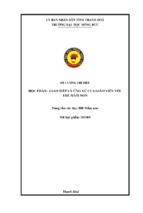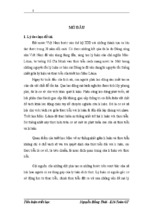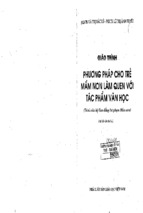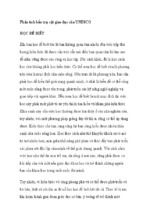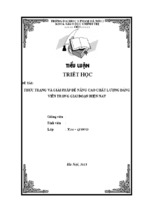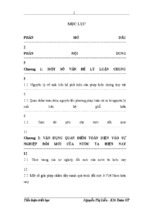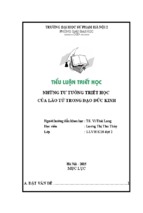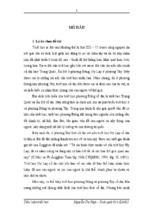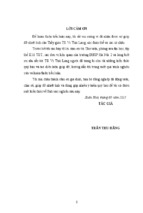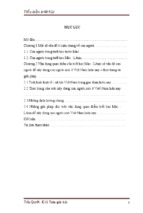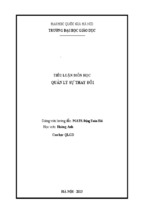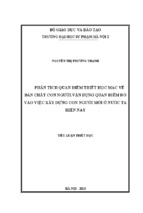Tài liệu chuyên về Hoá học
Jonathan Clayden (Mancheter University)
Nick Greevs (Liverpool University)
Stuart Warren (Cambridge University)
Peter Wothers (Cambridge University)
ORGANIC CHEMISTRY
C o n t e n t s
1.
What is organic chemistry?
1
Organic chemistry and you
Organic compounds
Organic chemistry and industry
Organic chemistry and the periodic table
1
1
6
11
Organic chemistry and this book
Connections
Boxes and margin notes
End-of-chapter problems
Colour
2.
Organic structures
19
Hydrocarbon frameworks and functionalgroups
Drawing molecules
Hydrocarbon frameworks
Functional groups
Carbon atoms carrying functional groups can
be classified byoxidation level
Naming compounds
Systematic nomenclature
What do chemists really call compounds?
How should you name compounds?
Problems
3.
35
37
37
40
43
45
47
50
56
65
72
78
78
Organic reactions
6.
81
83
86
87
95
100
105
110
110
Nucleophilic addition
carbonyl group
to
113
123
127
133
the
Molecular orbitals explain the rteactivityof the carbonyl
group
135
Cyanohydrins from the attack of cyanide on aldehydes
and ketones
137
The angle of nucleophilic attack on aldehydes and
ketones
139
Nucleophilic attack by ”hydride” on aldehydes and
ketones
139
Addition of organometallic reagents to aldehydes and
ketones
142
Addition of water to aldehydes and ketones
143
Hemiacetals from reaction of alcohols withaldehydes
and ketones
145
Acid and base catalysis of hemiacetal and hydrate
formation
146
Bisulfite addition compounds
148
Problems
150
7.
Delocalization and conjugation
Introduction
The structure of ethane (ethylene,CH2=CH2)
Molecules with more than one C-C doublebond
Conjugation
The allyl system
Other allyl-like system
The conjugation of two π bonds
UV and visible spectra
Aromaticity
Problems
8.
Structure of molecules
Introduction
Atomic structure
Summary of the importance of the quantum numbers
Atomic orbitals
Molecular orbitals – homonuclear diatomics
Heteronuclear diatomics
Hybridization of atomic orbitals
Conclusion
Problems
5.
20
21
26
31
Determining organic structures
Introduction
Mass spectrometry
Nuclear magnetic resonance
Infrared spectra
Mass spectra, NMR, and IR combined make quick
identification possible
Looking forward to Chapter 11 and 14
Problems
4.
14
15
15
16
Chemical reactions
Organic chemists use curly arrows to represent
reaction mechanisms
Drawing your own mechanisms with curlyarrows
Problems
Acidity, basicity, and pKa
Introduction
Acidity
The definition of pKa
Basicity
Neutral nitrogen bases
Neutral oxygen bases
pKa in action – the development of the drug cimetidine
Problems
9.
151
151
153
156
158
163
166
169
171
179
Using organometallic reagents to make
C-C bonds
181
182
185
197
199
203
204
207
Introduction
Organometallic compounds contain a carbon-metal
bond
Making organometallics
Using organometallics to make organic molecules
218
A closer look at some mechanisms
Problems
209
209
211
223
224
10. Conjugate addition
Conjugation changes the reactivity of carbonyl group
Alkenes conjugated with carbonyl groups are
polarized
Polarization is detectable spectroscopically
Molecular orbitals control conjugate addition
Ammonia and amines undergo conjugate addition
Conjugate addition of alcohols can be catalysed by
acid or base
Conjugate addition or direct addition to the carbonyl
group?
Copper (I) salts have a remarkableeffect on
organometallic reagents
Conclusion
Problems
227
229
229
230
231
233
234
239
240
241
11. Proton nuclear magnetic resonance
The differences between carbon and protonNMR
Integration tells us the number of hydrogen atoms
in each peak
Regions of the proton NMR spectrum
Protons on saturated carbon atoms
The alkene region and the benzene region
The aldehyde region: unsaturated carbon bonded to
oxygen
Coupling in the proton NMR spectrum
To conclude
Problems
12. Nucleophilic
substitution
carbonyl (C=O) group
at
243
244
245
246
251
255
258
274
275
the
The product of nucleophilic addition to a carbonyl
group is notalways stable compound
Carboxylic acid derivatives
Not all carboxylic acid derivatives are equally reactive
Making other compounds by substitution reaction
of acid derivatives
Making ketones from esters: the problem
Making ketones from esters: the solution
To summarize …
Problems
279
280
286
297
297
299
301
302
13. Equilibria, rates and mechanisms:
summary of mechanistic principles
How far and how fast?
305
How the equilibrium constant varies withthe difference
in energy between reactants and products
307
How to make the equilibrium favour the product you
want
310
Entropy is important in determining equilibrium
constant
312
Equilibrium constant vary with temperature
314
Making reactions go faster: the real reason reactions
are heated
315
Kinetics
319
Catalysis in carbonyl substitution ractions
323
The hydrolysis of amides can have termolecular kinetics325
The cis-trans isomerization of alkenes
326
Kinetic versus thermodynamic products
328
Low temperatures prevent unwanted reations from
occurring
331
Solvents
332
Summary of mechanisms from Chapters 6-12
334
Problems
336
14. Nucleophilic substitution at C=O with
loss of carbonyl oxygen
Introduction
339
Aldehydes can react with alcohols to form hemiacetrals 340
Acetals are formed from aldehydes or ketones plus
alcohols in the presenceof acids
342
Amines react with carbonyl compounds
348
Amines from imines: reduction amination
354
Substitution of C=O for C=C: a brief look at the Wittig
reation
357
Summary
358
Problems
358
15. Review of spectroscopic methods
There are three reasons for this chapter
Does spectroscopy help with the chemistry of the
carbonyl group?
Acid derivatives are best distinguished by infrared
Small rings introduce strain inside the ring and higher
s character outside it
Simple calculations of C=O stretching frequencies in
IR spectra
Interactions between different nuclei can give
enormous coupling constsants
Identifying products spectroscopically
Tables
Problems
361
361
364
365
367
368
371
374
379
16. Stereochemistry
Some compounds can exist as a pair of mirror-image
forms
381
The rotation of plane-polarized light is known as optical
activity
388
Diastereoisomers are stereoisomers that are not
enantiomers
390
Investigating the stereochemistry of a compound
397
Separating enantiomers is called resolution
399
Problems
404
17. Nucleophilic
substitution
saturated carbon
at
Nucleophilic substitution
Structure and stability of carbocations
The SN1 and SN2 mechanisms for nucleophilic
substitution
How can we decide which mechanism(SN1 or SN2)
will apply to a given organic compound?
The SN2 reaction
The leaving group
Nucleophiles
Nucleophiles in the SN2 reaction
Nucleophile and leaving groups compared
Looking forward: elimination and rearrangement
reactions
Problems
407
407
411
414
420
429
436
437
441
443
444
18. Conformational analysis
Bond rotation allows chains of atoms to adopt a
number of conformations
Conformation and configuration
Barriers to rotation
Conformations of ethane
Conformations of propane
Conformations of butane
Ring strain
A closer look at cyclohexane
Substituted cyclohexanes
Looking groups – t-butyl groups, decalins, and steroids
Axially and equatorially substituted rings react
447
448
449
450
450
450
452
455
460
463
differently
Rings containing sp2 hybridized carbon atoms:
cyclohexanone and cyclohexene
Multiple rings
To conclude
Problems
464
471
473
473
474
19. Elimination reactions
Substitution and elimination
477
Elimination happens when the nucleophilic attacks
hydrogen instead of carbon
478
How the nucleophile affects elimination versus
substitution
479
E1 and E2 mehanisms
480
Substrate structure may allow E1
482
The role of the leaving group
484
E1 reactions can be stereoselective
487
E1 reactions can be regioselective
489
E2 eliminations have anti-peroplanar transition state
490
E2 eliminations can be stereospecific
491
E2 eliminations from cyclohexanes
492
E2 elimination from vinyl halides: how to make alkynes493
The regioselectivity of E2 eliminations
494
Anion-stabilizing groups allow another mechanism
E1cB
495
To conclude …
500
Problems
501
20. Electrophilic addition to alkenes
Alkenes react with bromine
Oxidation of alkenes to form epoxides
Electrophilic addition to unsymmetrical alkenes is
regioselective
Eletrophilic addition to dienes
Unsymmetrical bromonium ions open regioselectively
Eletrophilic additions to alkenes can be tereoselctive
Bromonium ions as intermediates in stereoselective
synthesis
Iodolactonization and bromolactonization make new
rings
How to add water across a double bond
To conclude …
Problems
503
505
509
510
512
514
516
517
518
520
520
21. Formation and reactions of enols and
enolates
Would you accept a mixture of compounds as a pure
substance?
523
Tautomerism: formation of enols by transfer proton
524
Why don’t simple aldehydes and ketones exist as enols?525
Evidence for equilibriation of carbonyl compounds
with enols
525
Enolization is catalysed by acids and bases
526
The intermediate in the base-catalysed reaction is the
enolate ion
527
Summary of types of enol and enolate
528
Stable enols
531
Consequences of enolization
534
Reaction with enols or enolates as intermediates
535
Stable enolate equivalents
540
Enol and enolate reactions of oxygen: preparation of
enol ethers
541
Reaction of enol ethers
542
To conclude …
544
Problems
544
22. Electrophilic aromatic substitution
Introduction: enols and phenols
Benzene and its reaction with electrophiles
Electrophilic substitution of phenols
A nitrogen lone pair activates even more strongly
Alkyl benzenes react at the orto and para positions:
547
549
555
558
α donor substituents
561
Electronegative substituents give meta products
564
Halogens (F, Cl, Br, and I) both withdraw and donate
electrons
566
Why do some reactions stop cleantly at
monosubstitution?
568
Rewiew of important reactions including selectivity
571
Electrophilic substitution is the usual route to substituted
aromatic compounds
576
Problems
577
23. Electrophilic alkenes
Introduction – electrophilic alkenes
581
Nucleophilic conjugate addition to alkenes
582
Conjugate substitution reactions
585
Nucleophilic epoxidation
588
Nucleophilic aromatic substitution
589
The addition–elimination mechanism
590
Some medicinal chemistry – preparation of an antibiotic595
The SN1 mechanism for nucleophilic aromatic
substitution–diazonium compounds
597
The benzyne mechanism
600
Nucleophilic attack on allylic compounds
604
To conclude …
611
Problems
612
24. Chemoselectivity: selective reactions
and protection
Selectivity
Reducing agents
Reduction of carbonyl groups
Catalytic hydrogenation
Getting rid of functional groups
Dissolving metal reduction
One functional group may be more reactive than
another for kineticor forthermodynamic reasons
Oxidizing agents
To conclude
Problems
615
616
617
623
627
628
630
637
640
640
25. Synthesis in action
Introduction
Benzocaine
Saccharin
Salbutamol
Thyroxine
646
Muscalure: the sex pheromone of the house-fly
Grandisol: the sex pheromoneof the male cotton boll
weevil
Peptide synthesis: carbonyl chemistry in action
The synthesisi of dofetilide, a drug to combat erratic
heartbeat
Looking forward
Problems
643
644
644
645
648
649
651
658/
661
661
26. Alkylation of enolates
Carbonyl groups show diverse reactivity
663
Some important considerations that affect all alkylations664
Nitriles and nitrolkenes can be alkylated
664
Choise of electrophile for alkylation
667
Lithium enolates of carbonyl compounds
667
Alkylations of lithium enolates
668
Using specific enol equivalents to alkylate aldehydes
and ketones
671
Alkylation of β-dicarbonyl compounds
676
Ketone alkylation poses a problem in regioselectivity 680
Enones provide a solution to regioselectivity problems 683
To conclude …
687
Problems
688
27. Reactions of enolates with aldehydes
and ketones: the aldol reaction
Introduction: the aldol reaction
689
Cross-condensation
694
Compounds that can enolize but that are not
electrophilic
696
Controlling aldol reaction with specific enol
equivalents
697
Specific enol equivalents for carboxylic acid derivatives704
Specific enol equivalents for aldehydes
707
Specific enol equivalents for ketones
709
The Mannich reaction
712
Intramolecular aldol reaction
715
To conclude: a summary of equilibrium and directed
aldol methods
718
Problems
721
28. Acylation at carbon
Introduction: the Claisen ester condensation compared
to the aldol reaction
Problems with acylation at carbon
Acylation of enolates by esters
Crossed ester condensations
Summary of preparation of keto-esters by Claisen
reaction
Intramolecular crossed Claisen ester condensations
Directed C-acylation of enols and enolates
The acylation of enamines
`
Acylation of enols under acidic conditions
Acylation at nucleophilic carbon (other than enols and
enolates)
How nature makes fatty acids
To conclude …
Problems
723
725
726
728
733
734
736
739
740
742
743
746
746
29. Conjugate addition of enolates
Introduction: conjugate addition of enolates is a
Powerful synthetic transformation
Conjugate addition of enolates is the result of
thermodynamic control
A variety of electrophilic alkenes will accept
enol(ate) nucleophiles
Conjugate addition followed by cyclization makes
six–membered rings
Nitroalkanes are superb at conjugate addition
Problems
749
749
757
760
766
768
30. Retrosynthetic analysis
Creative chemistry
Retrosynthetic analysis: synthesis backward
Disconnections must correspond to known,
reliabile reactions
Synthons are idealized reagents
Choosing a disconnection
Multiple step syntheses: avoid chemoselectivity
problems
Functional group interconversion
Two-group disconnections are better than one
C-C disconnections
Donor and acceptor synthons
Two-group C-C disconnections
1,5 Related functional groups
Natural activity’ and ‘umpolung’
Problems
771
772
773
773
775
776
777
780
784
791
791
798
798
801
31. Controlling the geometry of double
bonds
The properties of alkenes depend on their geometry
803
Elimination reations are often unselective
803
The Julia olefination is regiospecific and connective
810
Stereospecific eliminations can give pure single isomers
of alkenes
812
The Peterson reaction is a stereospecific elimination
Perhaps the most important way of making alkenes –
the Wittig reaction
E- and Z- alkenes can be made by stereoselective
alkynes 818
Problems
1
32. Determination of stereochemistry by
spectroscopic methods
Introduction
3
J values vary with H-C-C-H dihedral angle
Stereochemistry of fused rings
The dihedral angle is not the only angle worth
measuring
Vicinal (3J) coupling constants in other ring sizes
Geminal (2J) coupling
Diastereotopic CH2 groups
Geminal coupling in six-membered rings
A surprising reaction product
The π contribution to geminal coupling
The nuclear Overhauser effect
To conclude …
Problems
812
814
addition to
82
823
824
828
830
831
834
835
841
842
844
844
848
848
33. Stereoselective reactions of cyclic
compounds
Introduction
Reations of small rings
Stereochemical control in six-membered rings
Conformational control in the formation of sixmembered rings
Stereochemistry of bicyclic compounds
Fused bicyclic compounds
Spirocyclic compounds
Reactions with cyclic intermediates or cyclic transition
states
To conclude …
Problems
851
852
856
861
862
863
870
871
879
879
34. Diastereoselectivity
Looking back
881
Making single diastereoisomers using stereospecific
reactions of alkenes
882
Stereoselective reactions
884
Prochirality
884
Additions to carbonyl groups can be diastereoselective
even without rings
887
Chelation can reverse stereoselectivity
892
Stereoselective reactions of acyclic alkenes
895
Aldol reactions can be stereoselective
898
Problems
903
35. Pericyclic reactions 1: cycloadditions
A new sort of reation
General description of the Diels-Alderreaction
The frontier orbital description of cycloadditions
The Diels-Alder reaction in more detail
Regioselectivity in Diels-Alder reactions
The Woodward-Hoffmann description of the DielsAlder reaction
Trapping reactive intermediates by Diels-Alder
reactions
Other thermal cycloadditions
Photochemical [2+2] cycloadditions
Thermal [2+2] cycloadditions
Making five-membered rings – 1,3-dipolar cycloadditions
Two very important synthetic reactions: cycloaddition
of alkenes with osmium tetroxide and with ozone
Summary of cycloaddition reactions
Problems
905
907
914
916
919
922
923
924
927
929
932
936
940
940
36. Pericyclic reactions 2: sigmatropic
and electrocyclic reactions
Sigmatropic rearrangements
Orbital description of [3,3]- sigmatropic rearrangements
The direction of [3,3]- sigmatropic rearrangements
[2,2]- Sigmatropic rearrangements
[1,3]- Sigmatropic hydrogen shifts
Electrocyclic reactions
Problems
943
946
947
951
953
956
966
37. Rearrangements
Neighbouring groups can accelerate substitution
reactions
Rearrangements occurs when a participatinggroups
ends up bonded to a different atom
Ring expansion means rearrangement
Carbocations rearrangements: blessing or course?
The pinacol rearrangement
The dienone-phenol rearrangement
The benzilic acid rearrangement
The Favorskii rearrangement
Migration to oxygen: the Baeyer-Villigerreaction
The Beckmann rearrangement
Problems
969
975
982
983
984
988
989
990
992
997
1000
38. Fragmentation
Polarization of C-C bonds helps fragmentation
Fragmentations are controlled by stereochemistry
A second synthesis of longifolene
The synthesis of nootkatone
A revision example: rearrangements and
fragmentation
Problems
1003
1005
1010
1011
1014
1017
39. Radical reactions
Radicals contain unpaired electrons
1021
Most radicals are extremely reactive …
1022
How to analyse the structure of radicals: electron spin
resonance
1024
Radicals have singly occupied molecular orbitals
1025
Radical stability
1026
How do radicals react?
1029
Titanium promotes the pinacol couplingthen
deoxygenates the products: the McMurry reaction
1031
Radical chain reactions
1033
Selectivity in radical chain reactions
1035
Selective radical bromination: allylic substitution of H
by Br
1039
Controlling radical chains
1041
The reactivity pattern of radicals is quite different
from that of polar reagents
1047
An alternative way of making alkyl radicals: the mercury
method
1048
Intramolecular radical reactions are moreefficient
that intermolecular ones
1049
Problems
1051
40. Synthesis and reactions of carbenes
Diazomethane makes methyl esters from carboxylic
Acids
Photolysis of diazomethane produces a carbene
How are carbenes formed?
Carbenes can be devided into two types
How do carbenes react?
Alkene (olefin) metathesis
Summary
Problems
1053
1055
1056
1060
1063
1074
1076
1076
41. Determining reaction mechanisms
There are mechanisms and there are mechanisms
1079
Determinating reaction mechanisms – the Cannizzaro
reaction
Be sure of the structure of the product
Systematic structural variation
The Hammett relationship
Other kinetic evidence
Acid and base catalysis
The detection of intermediates
Stereochemistry and mechanism
Summary of methods for the investigation of
mechanism
Problems
42. Saturated
heterocycles
stereoelectronics
1081
1084
1089
1090
1100
1102
1109
1113
1117
1118
and
Introduction
Reactions of heterocycles
Conformation of saturated heterocycles: the anomeric
effect
Making heterocycles: ring-closing reactions
Problems
1121
1121
1128
1134
1144
43. Aromatic heterocycles 1: structures
and reations
Introduction
Aromatcity survives when parts of benzene’s ring are
replaced by nitrogen atoms
Pyridine is a very unreactive aromatic imine
Six-membered aromatic heterocycles can have oxygen
in the ring
Five-membered heterocycles are good nucleophiles
Furan and thiophene are oxygen and sulfur analogues
of pyrrole
More reactions of five-membered heterocycles1162
Five-membered rings with two or more nitrogen atoms
Benzo-fused heterocycles
Putting more nitrogen atoms in a six-membered ring
Fusing rings to pyridines: quinolines andisoquinolines
Heterocycles can have many nitrogens but only one
sulfur or oxygen in any ring
There are thousands more heterocycles out there
Which heterocyclic structures should you learn?
Problems
1147
1148
1149
1156
1157
1159
1165
1169
1172
1174
1176
1176
1180
1182
44. Aromatic heterocycles 2: synthesis
Thermodynamics is one our side
1185
Disconnect the carbon-heteroatom bonds first1
1186
Pyrroles, thiophenes, and furans from 1,4-dicarbonyl
compounds
1188
How to make pyridines: the Hantzsch pyridine
synthesis
1191
Pyrazoles and pyridazines from hydrazine and
dicarbonyl compounds
1195
Pyrimidines can be made from 1,3-dicarbonyl compounds
and amidines
1198
Unsymmetrical nucleophiles lead to selectivity
questions
1199
Izoxazoles are made from hydroxylamine or by
1,3-dipolar cycloadditions
1200
Tetrazoles are also made by 1,3-dipolar cycloadditions 1202
The Fischer indole synthesis
1204
Quinolines and isoquinolines
1209
More heteroatoms in fused rings mean more choise in
synthesis
1212
Summary: the three major approaches to the synthesisof
aromatic heterocycles
1214
Problems
1217
45. Asymmetric synthesis
Nature is asymmetrical – Nature in the looking-glass 1219
Resolution can be used to separateenantiomers
1221
The chiral pool – Nature’s ‘ready-made’ chiral centers 1222
Asymmetric synthesis
Chiral reagents and chiral catalysts
Problems
46. Organo-main-group
sulfur
1225
1233
1244
chemistry
1:
Sulfur: an element of contradictions
Sulfur-stabilized anions
Sulfonium salts
Sulfonium ylids
Thiocarbonyl compounds
Sulfoxides
Other oxidations with sulfur and selenium
To conclude: the sulfur chemistry of onions and garlic
Problems
47. Organo-main-group chemistry
boron, silicon, and tin
1247
1251
1255
1258
1264
1265
1270
1272
1273
2:
Organic chemists make extensive use of the periodic
table
Boron
Silicon and carbon compared
Organotin compounds
Problems
1277
1278
1287
1304
1308
48. Organometallic chemistry
Transition metals extend the range of organic reactions 1311
Transition metal complexes exibit special bonding
1315
Palladium (0) is most widely used in homogenous
catalysis
1319
Alkenes are attacked by nucleophiles when coordinated
to palladium (II)
1336
Palladium catalysis in the total synthesis of a natural
alkaloid
1338
Other transition metals: cobalt
1339
Problems
1341
49. The chemistry of life
Primary metabolism
Life begins with nucleic acids
Proteins are made of amino acids
Sugars – just energy sources?
Glycosides are everywhere in nature
Most sugars are embedded in carbohydrates
Lipids
Bacteria and people have slightly different chemistry
Problems
1388
1392
1397
1399
1400
1406
1411
51. Natural products
Introduction
Natural products come from secondary metabolism
Alkaloids are basic compounds from amino acid
metabolism
Fatty acids and other poliketides are made from
acetyl CoA
Aromatic poliketides come in great variety
Terpenes are volatile constituents of plant resins and
essential oils
Steroids are metabolites of terpene origin
Biomimetic synthesis: learning from Nature
Problems
1413
1414
1414
1425
1433
1437
1441
1446
1447
52. Polymerization
Monomers, dimmers, and oligomers
Polimerazation by carbonyl substitution reactions
Polimerazation by electrophilic aromatic substitution
Polimerazation by the SN2 reaction
Polimerazation by nucleophilic attack on isocyanates
Polimerazation of alkenes
Co-polymerization
Cross-linked polymers
Reactions of polymers
Biodedegradable polymers and plastics
Chemical reagents can be bonded to polymers
Problems
1451
1453
1455
1456
1458
1459
1464
1466
1468
1472
1473
1478
53. Organic chemistry today
1345
1347
1353
1359
1368
1372
1374
1377
1379
50. Mechanisms in biological chemistry
Nature’s NaBH4 is a nucleotide: NADH or NADPH
Reductive amination in nature
Nature’s enols – lysine enamines and coenzyme A
Nature’s acyl anion equivalent (d1 reagent) is thiamine
pyrophosphate
Rearrangements in the biosynthesis of valine and
isoleucine
Carbon dioxide is carried by biotin
The shikimic acid pathway
Haemoglobin carries oxygen as an iron (II) complex
Problems
1381
1384
Modern science is based on interaction between
disciplines
The synthesis of Crixivan
The future of organic chemistry
Index
1481
1483
1487
1491
1
What is organic chemistry?
Organic chemistry and you
You are already a highly skilled organic chemist. As you read these words, your eyes are using an
organic compound (retinal) to convert visible light into nerve impulses. When you picked up this
book, your muscles were doing chemical reactions on sugars to give you the energy you needed. As
you understand, gaps between your brain cells are being bridged by simple organic molecules (neurotransmitter amines) so that nerve impulses can be passed around your brain. And you did all that
without consciously thinking about it. You do not yet understand these processes in your mind as
well as you can carry them out in your brain and body. You are not alone there. No organic chemist,
however brilliant, understands the detailed chemical working of the human mind or body very well.
We, the authors, include ourselves in this generalization, but we are going to show you in this
book what enormous strides have been taken in the understanding of organic chemistry since the
science came into being in the early years of the nineteenth century. Organic chemistry began as a
tentative attempt to understand the chemistry of life. It has grown into the confident basis of vast
multinational industries that feed, clothe, and cure millions of people without their even being
aware of the role of chemistry in their lives. Chemists cooperate with physicists and mathematicians to understand how molecules behave and with biologists to understand how molecules
determine life processes. The development of these ideas is already a revelation at the beginning of
the twenty-first century, but is far from complete. We aim not to give you the measurements of the
skeleton of a dead science but to equip you to understand the conflicting demands of an
adolescent one.
Like all sciences, chemistry has a unique place in our pattern of understanding of the universe. It
is the science of molecules. But organic chemistry is something more. It literally creates itself as it
grows. Of course we need to study the molecules of nature both because they are interesting in their
own right and because their functions are important to our lives. Organic chemistry often studies life
by making new molecules that give information not available from the molecules actually present in
living things.
This creation of new molecules has given us new materials such as plastics, new dyes to colour our
clothes, new perfumes to wear, new drugs to cure diseases. Some people think that these activities are
unnatural and their products dangerous or unwholesome. But these new molecules are built by
humans from other molecules found on earth using the skills inherent in our natural brains. Birds
build nests; man makes houses. Which is unnatural? To the organic chemist this is a meaningless distinction. There are toxic compounds and nutritious ones, stable compounds and reactive ones—but
there is only one type of chemistry: it goes on both inside our brains and bodies and also in our flasks
and reactors, born from the ideas in our minds and the skill in our hands. We are not going to set
ourselves up as moral judges in any way. We believe it is right to try and understand the world about
us as best we can and to use that understanding creatively. This is what we want to share with
you.
Organic compounds
Organic chemistry started as the chemistry of life, when that was thought to be different from the
chemistry in the laboratory. Then it became the chemistry of carbon compounds, especially those
found in coal. Now it is both. It is the chemistry of the compounds of carbon along with other elements such as are found in living things and elsewhere.
H
O
11-cis-retinal
absorbs light when we see
NH2
HO
N
H
serotonin
human neurotransmitter
P
We are going to give you
structures of organic compounds
in this chapter—otherwise it
would be rather dull. If you do not
understand the diagrams, do not
worry. Explanation is on its way.
1 . What is organic chemistry?
2
L
You will be able to read towards the
end of the book (Chapters 49–51)
about the extraordinary chemistry that
allows life to exist but this is known
only from a modern cooperation
between chemists and biologists.
The organic compounds available to us today are those present in living things and those formed
over millions of years from dead things. In earlier times, the organic compounds known from nature
were those in the ‘essential oils’ that could be distilled from plants and the alkaloids that could be
extracted from crushed plants with acid. Menthol is a famous example of a flavouring compound
from the essential oil of spearmint and cis-jasmone an example of a perfume distilled from jasmine
flowers.
O
N
HO
OH
cis-jasmone
MeO
menthol
quinine
N
Even in the sixteenth century one alkaloid was famous—quinine was extracted from the bark of
the South American cinchona tree and used to treat fevers, especially malaria. The Jesuits who did
this work (the remedy was known as ‘Jesuit’s bark’) did not of course know what the structure of
quinine was, but now we do.
The main reservoir of chemicals available to the nineteenth century chemists was coal. Distillation of coal to give gas for lighting and heating (mainly hydrogen and carbon monoxide) also
gave a brown tar rich in aromatic compounds such as benzene, pyridine, phenol, aniline, and
thiophene.
NH2
OH
S
N
benzene
aniline
phenol
pyridine
thiophene
Phenol was used by Lister as an antiseptic in surgery and aniline became the basis for the dyestuffs
industry. It was this that really started the search for new organic compounds made by chemists
rather than by nature. A dyestuff of this kind—still available—is Bismarck Brown, which should tell
you that much of this early work was done in Germany.
H2N
NH2
N
H2N
NH2
N
N
N
Bismarck Brown Y
L
You can read about polymers and
plastics in Chapter 52 and about fine
chemicals throughout the book.
CH3
(CH2)n
CH3
n = an enormous number
length of molecule is n + 2
carbon atoms
CH3
(CH2)n
CH2
CH3
n = an enormous number
length of molecule is n + 3
carbon atoms
In the twentieth century oil overtook coal as the main source of bulk organic compounds so that
simple hydrocarbons like methane (CH4, ‘natural gas’) and propane (CH3CH2CH3, ‘calor gas’)
became available for fuel. At the same time chemists began the search for new molecules from new
sources such as fungi, corals, and bacteria and two organic chemical industries developed in parallel—‘bulk’ and ‘fine’ chemicals. Bulk chemicals like paints and plastics are usually based on simple
molecules produced in multitonne quantities while fine chemicals such as drugs, perfumes, and
flavouring materials are produced in smaller quantities but much more profitably.
At the time of writing there were about 16 million organic compounds known. How many more
are possible? There is no limit (except the number of atoms in the universe). Imagine you’ve just
made the longest hydrocarbon ever made—you just have to add another carbon atom and you’ve
made another. This process can go on with any type of compound ad infinitum.
But these millions of compounds are not just a long list of linear hydrocarbons; they embrace all
kinds of molecules with amazingly varied properties. In this chapter we offer a selection.
Organic compounds
What do they look like? They may be crystalline solids, oils,
waxes, plastics, elastics, mobile or volatile liquids, or gases.
Familiar ones include white crystalline sugar, a cheap natural
compound isolated from plants as hard white crystals when pure,
and petrol, a mixture of colourless, volatile, flammable hydrocarbons. Isooctane is a typical example and gives its name to the
octane rating of petrol.
The compounds need not lack colour. Indeed we can soon
dream up a rainbow of organic compounds covering the whole
spectrum, not to mention black and brown. In this table we have
avoided dyestuffs and have chosen compounds as varied in structure as possible.
s
HO
HO
HO
Colour
Description
Compound
red
dark red hexagonal plates
3′-methoxybenzocycloheptatriene2′-one
p
O
HO O
OH
HO
O
OH
amber needles
HO
sucrose – ordinary sugar
isolated from sugar cane
or sugar beet
white crystalline solid
Structure
O
O
dichloro dicyano quinone (DDQ)
Cl
CN
e
Cl
CN
O
c
yellow
toxic yellow explosive gas
diazomethane
green
green prisms with a
steel-blue lustre
9-nitroso julolidine
t
CH2
N
N
N
r
NO
blue
deep blue liquid with a
peppery smell
azulene
purple
deep blue gas condensing
to a purple solid
nitroso trifluoromethane
u
F
N
C
F
O
F
m
Colour is not the only characteristic by which we recognize compounds. All too often it is their
odour that lets us know they are around. There are some quite foul organic compounds too; the
smell of the skunk is a mixture of two thiols—sulfur compounds containing SH groups.
skunk spray contains:
SH +
SH
CH3
CH3
MeO
orange
3
CH3
CH3
CH
C
C
H2
CH3
isooctane (2,3,5-trimethylpentane)
a major constiuent of petrol
volatile inflammable liquid
1 . What is organic chemistry?
4
S
thioacetone
?
S
S
S
trithioacetone;
Freiburg was evacuated
because of a smell from
the distillation this compound
HS
SH
O
HS
4-methyl-4sulfanylpentan2-one
propane
dithiol
two candidates for
the worst smell in the world
no-one wants to find the winner!
S
S
CH3
CH3
the divine smell
of the black truffle
comes from this compound
O
damascenone - the smell of roses
But perhaps the worst aroma was that which caused the evacuation of the city of Freiburg in 1889.
Attempts to make thioacetone by the cracking of trithioacetone gave rise to ‘an offensive smell which
spread rapidly over a great area of the town causing fainting, vomiting and a panic evacuationºthe
laboratory work was abandoned’.
It was perhaps foolhardy for workers at an Esso research station to repeat the experiment of cracking trithioacetone south of Oxford in 1967. Let them take up the story. ‘Recentlyºwe found ourselves
with an odour problem beyond our worst expectations. During early experiments, a stopper jumped
from a bottle of residues, and, although replaced at once, resulted in an immediate complaint of nausea and sickness from colleagues working in a building two hundred yards away. Two of our
chemists who had done no more than investigate the cracking of minute amounts of trithioacetoneºfound themselves the object of hostile stares in a restaurant and suffered the humiliation of
having a waitress spray the area around them with a deodorantº. The odours defied the expected
effects of dilution since workers in the laboratory did not find the odours intolerable . . . and genuinely denied responsibility since they were working in closed systems. To convince them otherwise,
they were dispersed with other observers around the laboratory, at distances up to a quarter of a
mile, and one drop of either acetone gem-dithiol or the mother liquors from crude trithioacetone
crystallisations were placed on a watch glass in a fume cupboard. The odour was detected downwind
in seconds.’
There are two candidates for this dreadful smell—propane dithiol (called acetone gem-dithiol
above) or 4-methyl-4-sulfanylpentan-2-one. It is unlikely that anyone else will be brave enough to
resolve the controversy.
Nasty smells have their uses. The natural gas piped to our homes contains small amounts of deliberately added sulfur compounds such as tert-butyl thiol (CH3)3CSH. When we say small, we mean
very small—humans can detect one part in 50 000 000 000 parts of natural gas.
Other compounds have delightful odours. To redeem the honour of sulfur compounds we must
cite the truffle which pigs can smell through a metre of soil and whose taste and smell is so delightful
that truffles cost more than their weight in gold. Damascenones are responsible for the smell of roses.
If you smell one drop you will be disappointed, as it smells rather like turpentine or camphor, but
next morning you and the clothes you were wearing will smell powerfully of roses. Just like the compounds from trithioacetone, this smell develops on dilution.
Humans are not the only creatures with a sense of smell. We can find mates using our eyes alone
(though smell does play a part) but insects cannot do this. They are small in a crowded world and
they find others of their own species and the opposite sex by smell. Most insects produce volatile
compounds that can be picked up by a potential mate in incredibly weak concentrations. Only 1.5
mg of serricornin, the sex pheromone of the cigarette beetle, could be isolated from 65 000 female
beetles—so there isn’t much in each beetle. Nevertheless, the slightest whiff of it causes the males to
gather and attempt frenzied copulation.
The sex pheromone of the Japanese beetle, also given off by the females, has been made by
chemists. As little as 5 µg (micrograms, note!) was more effective than four virgin females in attracting the males.
OH
O
O
O
H
serricornin
japonilure
the sex pheromone of the cigarette beetle
Lasioderma serricorne
the sex pheromone of the Japanese beetle
Popilia japonica
The pheromone of the gypsy moth, disparlure, was identified from a few µg isolated from the
moths and only 10 µg of synthetic material. As little as 2 × 10–12 g is active as a lure for the males in
field tests. The three pheromones we have mentioned are available commercially for the specific
trapping of these destructive insect pests.
Organic compounds
Don’t suppose that the females always do all the work; both
male and female olive flies produce pheromones that attract the
other sex. The remarkable thing is that one mirror image of
the molecule attracts the males while the other attracts the
females!
O
disparlure
disparlure
the sex pheromone of the Gypsy moth
th
f th G
th
Portheria hdispar
O
O
5
O
O
O
O
olean
sex pheromone of the olive fly
Bacrocera oleae
this mirror image isomer
attracts the males
this mirror image isomer
attracts the females
What about taste? Take the grapefruit. The main flavour comes from another sulfur compound
and human beings can detect 2 × 10–5 parts per billion of this compound. This is an almost unimaginably small amount equal to 10–4 mg per tonne or a drop, not in a bucket, but in a good-sized lake.
Why evolution should have left us abnormally sensitive to grapefruit, we leave you to imagine.
For a nasty taste, we should mention ‘bittering agents’, put into dangerous household substances
like toilet cleaner to stop children eating them by accident. Notice that this complex organic compound is actually a salt—it has positively charged nitrogen and negatively charged oxygen atoms—
and this makes it soluble in water.
HS
flavouring principle of grapefruit
O
H
N
O
N
O
bitrex
denatonium benzoate
benzyldiethyl[(2,6-xylylcarbamoyl)methyl]ammonium benzoate
Other organic compounds have strange effects on humans. Various ‘drugs’ such
OH
as alcohol and cocaine are taken in various ways to make people temporarily happy. CH3
alcohol
They have their dangers. Too much alcohol leads to a lot of misery and any cocaine
(ethanol)
at all may make you a slave for life.
Again, let’s not forget other creatures. Cats seem to be able to go to sleep at any
time and recently a compound was isolated from the cerebrospinal fluid of cats that makes them, or
rats, or humans go off to sleep quickly. It is a surprisingly simple compound.
CO2Me
CH3
N
O
O
cocaine
- an addictive alkaloid
O
NH2
a sleep-inducing fatty acid derivative
cis-9,10-octadecenoamide
This compound and disparlure are both derivatives of fatty
acids, molecules that feature in many of the food problems people
are so interested in now (and rightly so). Fatty acids in the diet are
a popular preoccupation and the good and bad qualities of saturates, monounsaturates, and polyunsaturates are continually in
the news. This too is organic chemistry. One of the latest molecules to be recognized as an anticancer agent in our diet is CLA
(conjugated linoleic acid) in dairy products.
O
1
11
9
18
12
10
CLA (Conjugated Linoleic Acid)
cis-9-trans-11 conjugated linoleic acid
dietary anticancer agent
OH
1 . What is organic chemistry?
6
P
Vitamin C (ascorbic acid) is a
vitamin for primates, guinea-pigs,
and fruit bats, but other mammals
can make it for themselves.
OH
H
HO
O
OH
Another fashionable molecule is resveratrole, which may
be responsible for the beneficial effects of red wine in preHO
venting heart disease. It is a quite different organic compound with two benzene rings and you can read about it in
Chapter 51.
OH
For our third edible molecule we choose vitamin C. This is
resveratrole from the skins of grapes
an essential factor in our diets—indeed, that is why it is called
is this the compound in red wine
a vitamin. The disease scurvy, a degeneration of soft tissues, which
helps to prevent heart disease?
particularly in the mouth, from which sailors on long voyages
like those of Columbus suffered, results if we don’t have vitamin C. It also is a universal antioxidant,
scavenging for rogue free radicals and so protecting us against cancer. Some people think an extra
large intake protects us against the common cold, but this is not yet proved.
O
Organic chemistry and industry
HO
OH
vitamin C (ascorbic acid)
Vitamin C is manufactured on a huge scale by Roche, a Swiss company. All over the world there are
chemistry-based companies making organic molecules on scales varying from a few kilograms to
thousands of tonnes per year. This is good news for students of organic chemistry; there are lots of
jobs around and it is an international job market. The scale of some of these operations of organic
chemistry is almost incredible. The petrochemicals industry processes (and we use the products!)
over 10 million litres of crude oil every day. Much of this is just burnt in vehicles as petrol or diesel,
but some of it is purified or converted into organic compounds for use in the rest of the chemical
industry. Multinational companies with thousands of employees such as Esso (Exxon) and Shell
dominate this sector.
Some simple compounds are made both from oil and from plants. The ethanol used as a starting
material to make other compounds in industry is largely made by the catalytic hydration of ethylene
from oil. But ethanol is also used as a fuel, particularly in Brazil where it is made by fermentation of
sugar cane wastes. This fuel uses a waste product, saves on oil imports, and has improved the quality
of the air in the very large Brazilian cities, Rio de Janeiro and São Paulo.
Plastics and polymers take much of the production of the petromonomers for polymer
manufacture
chemical industry in the form of monomers such as styrene, acrylates, and vinyl chloride. The products of this enormous industry are
everything made of plastic including solid plastics for household
goods and furniture, fibres for clothes (24 million tonnes per
annum), elastic polymers for car tyres, light bubble-filled polymers
styrene
for packing, and so on. Companies such as BASF, Dupont, Amoco,
X
Monsanto, Laporte, Hoechst, and ICI are leaders here. Worldwide
Cl
polymer production approaches 100 million tonnes per annum and
O
PVC manufacture alone employs over 50 000 people to make over 20
acrylates
vinyl chloride
million tonnes per annum.
The washing-up bowl is plastic too but the detergent you put in it belongs to another branch of
the chemical industry—companies like Unilever (Britain) or Procter and Gamble (USA) which
produce soap, detergent, cleaners, bleaches,
Ingredients
polishes, and all the many essentials for the
aqua, palmitic acid,
modern home. These products may be lemon
triethanolamine,
glycereth-26, isopentane,
and lavender scented but they too mostly come
oleamide-DEA, oleth-2,
from the oil industry. Nowadays, most prostearic acid, isobutane,
ducts of this kind tell us, after a fashion, what is in
PEG-14M, parfum,
them. Try this example—a well known brand of
allantoin,
hydroxyethyl-cellulose,
shaving gel along with the list of contents on the
hydroxypropyl-cellulose,
container:
PEG-150 distearate,
Does any of this make any sense?
CI 42053, CI 47005
Organic chemistry and industry
It doesn’t all make sense to us, but here is a possible interpretation. We certainly hope the book
will set you on the path of understanding the sense (and the nonsense!) of this sort of thing.
Ingredient
aqua
Chemical meaning
water
Purpose
solvent
palmitic acid
CH3(CH2)14CO2H
acid, emulsifier
triethanolamine
N(CH2CH2OH)3
base
glycereth-26
glyceryl(OCH2CH2)26OH
surfactant
isopentane
(CH3)2CHCH2CH3
propellant
oleamide-DEA
CH3(CH2)7CH=CH(CH2)7CONEt2
oleth-2
Oleyl(OCH2CH2)2OH
surfactant
stearic acid
CH3(CH2)16CO2H
acid, emulsifier
isobutane
(CH3)2CHCH3
propellant
PEG-14M
polyoxyethylene glycol ester
surfactant
parfum
perfume
H
N
allantoin
H2N
promotes healing in
case you cut
yourself while shaving
NH
O
N
H
allantoin
O
hydroxyethyl-cellulose
cellulose fibre from wood pulp
with –OCH2CH2OH groups added
gives body
hydroxypropyl-cellulose
cellulose fibre from wood pulp
gives body
with –OCH2CH(OH)CH3 groups added
PEG-150 distearate
polyoxyethylene glycol diester
surfactant
CI 42053
Fast Green FCF (see box)
green dye
CI 47005
Quinoline Yellow (see box)
yellow dye
The structures of two dyes
Fast Green FCF and Quinoline Yellow are colours permitted to be used in foods and cosmetics and have the structures
shown here. Quinoline Yellow is a mixture of isomeric sulfonic acids in the two rings shown.
OO2S
Et
Et
N
N
2Na
SO2O
Fast Green FCF
O
SO2O
N
OH
HOO2S
SO2OH
Quinoline Yellow
OH
The particular acids, bases, surfactants, and so on are chosen to blend together in a smooth emulsion when propelled from the can. The result should feel, smell, and look attractive and a greenish
colour is considered clean and antiseptic by the customer. What the can actually says is this:
‘Superior lubricants within the gel prepare the skin for an exceptionally close, comfortable and effective shave. It contains added moisturisers to help protect the skin from razor burn. Lightly
fragranced.’
7
1 . What is organic chemistry?
8
CN
O
CH3
O
Superglue bonds things together
when this small molecule
joins up with hundreds of its fellows
in a polymerization reaction
L
The formation of polymers is discussed
in Chapter 52.
Another oil-derived class of organic chemical business includes adhesives, sealants, coatings, and
so on, with companies like Ciba–Geigy, Dow, Monsanto, and Laporte in the lead. Nowadays aircraft
are glued together with epoxy-resins and you can glue almost anything with ‘Superglue’ a polymer of
methyl cyanoacrylate.
There is a big market for intense colours for dyeing cloth, colouring plastic and paper, painting
walls, and so on. This is the dyestuffs and pigments industry and leaders here are companies like ICI
and Akzo Nobel. ICI have a large stake in this aspect of the business, their paints turnover alone
being £2 003 000 000 in 1995.
The most famous dyestuff is probably indigo, an ancient dye that used to be isolated from plants
but is now made chemically. It is the colour of blue jeans. More modern dyestuffs can be represented
by ICI’s benzodifuranones, which give fashionable red colours to synthetic fabrics like polyesters.
We see one type of pigment around us all the time in the form of the colours on plastic bags.
Among the best compounds for these are the metal complexes called phthalocyanines. Changing the
metal (Cu and Fe are popular) at the centre and the halogens round the edge of these molecules
changes the colour but blues and green predominate. The metal atom is not necessary for intense
pigment colours—one new class of intense ‘high performance’ pigments in the orange–red range are
the DPP (1,4-diketopyrrolo[3,4-c]pyrroles) series developed by Ciba–Geigy. Pigment Red 254 is
used in paints and plastics.
OR
Cl
Cl
Cl
Cl
Cl
N
Cl
O
O
Cl
N
O
O
N
Cu
N
O
Cl
Cl
HN
N
NH
O
N
NH
N
O
Cl
O
HN
Cl
OR
Cl
N
Cl
Cl
Cl
indigo
the colour of blue jeans
L
You can read in Chapter 7 why some
compounds are coloured and others
not.
ICI’s Dispersol
benzodifuranone
red dyes for polyester
Ciba Geigy’s Pigment Red 254
an intense DPP pigment
H
N
N
light, silver
OPh
HN
R
N
N
O
photographic
developer
colourless
aromatic amine
Cl
Colour photography starts with inorganic silver halides but they are carried on organic gelatin.
Light acts on silver halides to give silver atoms that form the photographic image, but only in black
and white. The colour in films like Kodachrome then comes from the coupling of two colourless
organic compounds. One, usually an aromatic amine, is oxidized and couples with the other to give a
coloured compound.
NH
NEt2
Cl
ICI’s Monastral Green GNA
a good green for plastic objects
R
NH2
Cl
OPh
SO2O Na
O
Na
SO2O
NEt2
NEt2
magenta pigment from two
colourless compounds
colourless cyclic amide
Organic chemistry and industry
That brings us to flavours and fragrances. Companies like International Flavours and Fragrances
(USA) or Givaudan–Roure (Swiss) produce very big ranges of fine chemicals for the perfume, cosmetic, and food industries. Many of these will come from oil but others come from plant sources. A
typical perfume will contain 5–10% fragrances in an ethanol/water (about 90:10) mixture. So the
perfumery industry needs a very large amount of ethanol and, you might think, not much perfumery
material. In fact, important fragrances like jasmine are produced on a >10 000 tonnes per annum
scale. The cost of a pure perfume ingredient like cis-jasmone, the main ingredient of jasmine, may be
several hundred pounds, dollars, or euros per gram.
The world of perfumery
Perfume chemists use extraordinary language to describe
their achievements: ‘Paco Rabanne pour homme was
created to reproduce the effect of a summer walk in the
open air among the hills of Provence: the smell of herbs,
rosemary and thyme, and sparkling freshness with cool
sea breezes mingling with warm soft Alpine air. To
achieve the required effect, the perfumer blended
herbaceous oils with woody accords and the synthetic
aroma chemical dimethylheptanol which has a
penetrating but indefinable freshness associated with
open air or freshly washed linen’. (J. Ayres, Chemistry and
Industry, 1988, 579)
Chemists produce synthetic flavourings such as ‘smoky bacon’ and even ‘chocolate’. Meaty
flavours come from simple heterocycles such as alkyl pyrazines (present in coffee as well as roast
meat) and furonol, originally found in pineapples. Compounds such as corylone and maltol give
caramel and meaty flavours. Mixtures of these and other synthetic compounds can be ‘tuned’ to taste
like many roasted foods from fresh bread to coffee and barbecued meat.
O
HO
N
HO
O
O
HO
N
O
an alkyl pyrazine
from coffee and
roast meat
O
maltol
E-636 for cakes
and biscuits
corylone
caramel
roasted taste
furonol
roast meat
Some flavouring compounds are also perfumes and may also be used as an intermediate in
making other compounds. Two such large-scale flavouring compounds are vanillin (vanilla flavour
as in ice cream) and menthol (mint flavour) both manufactured on a large scale and with many
uses.
O
vanillin
found in vanilla pods;
manufactured
on a large scale
CH3O
OH
H
menthol
extracted from mint;
25% of the world’s supply
manufactured
HO
Food chemistry includes much larger-scale items than flavours. Sweeteners such as sugar itself are
isolated from plants on an enormous scale. Sugar’s structure appeared a few pages back. Other
sweeteners such as saccharin (discovered in 1879!) and aspartame (1965) are made on a sizeable
scale. Aspartame is a compound of two of the natural amino acids present in all living things and is
made by Monsanto on a large scale (over 10 000 tonnes per annum).
CO2H
H
N
H2N
methyl ester of
phenylalanine
CO2H
O
OCH3
O
aspartame (‘NutraSweet’)
200 × sweeter than sugar
is made from
two amino acids –
H
N
H2N
O
OCH3
O
aspartic
acid
9
O
cis-jasmone
the main compound
in jasmine perfume
10
1 . What is organic chemistry?
The pharmaceutical businesses produce drugs and medicinal products of many kinds. One of the
great revolutions of modern life has been the expectation that humans will survive diseases because
of a treatment designed to deal specifically with that disease. The most successful drug ever is ranitidine (Zantac), the Glaxo–Wellcome ulcer treatment, and one of the fastest-growing is Pfizer’s sildenafil (Viagra). ‘Success’ refers both to human health and to profit!
You will know people (probably older men) who are ‘on β-blockers’. These are compounds designed to block the effects of adrenaline (epinephrine) on the heart and hence to
prevent heart disease. One of the best is Zeneca’s tenormin. Preventing high blood pressure also prevents heart disease and certain specific enzyme inhibitors (called ‘ACE-inhibitors’) such as
Squibb’s captopril work in this way. These are drugs that imitate substances naturally present in the
body.
The treatment of infectious diseases relies on antibiotics such as the penicillins to prevent bacteria
from multiplying. One of the most successful of these is Smith Kline Beecham’s amoxycillin. The
four-membered ring at the heart of the molecule is the ‘β-lactam’.
EtO
NO2
Me2N
N
H
O
S
NHMe
N
N
Me
Glaxo-Wellcome’s ranitidine
the most successful drug to date
world wide sales peaked >£1,000,000,000 per annum
O
N
N
S
OH
Me
N
OO
NH
Pfizer’ssildenafil
sildenafil(Viagra)
(Viagra)
Pfizer’s
OO
threemillion
millionsatisfied
satisfiedcustomers
customersinin1998
1998
three
NH2
H
N
HS
N
O
CO2H
Squibb’s captopril
specific enzyme inhibitor
for treatment and
prevention of hypertension
Zeneca’s tenormin
cardioselective β-blocker
for treatment and prevention
of heart disease
H H
N
S
N
O
HO
H
O
SmithKline Beecham’s amoxycillin
β-lactam antibiotic
for treatment of bacterial infections
CO2H
We cannot maintain our present high density of population in the developed world, nor deal with
malnutrition in the developing world unless we preserve our food supply from attacks by insects and
fungi and from competition by weeds. The world market for agrochemicals is over £10 000 000 000
per annum divided roughly equally between herbicides, fungicides, and insecticides.
At the moment we hold our own by the use of agrochemicals: companies such as RhônePoulenc, Zeneca, BASF, Schering–Plough, and Dow produce compounds of remarkable and specific
activity. The most famous modern insecticides are modelled on the natural pyrethrins, stabilized
against degradation by sunlight by chemical modification (see coloured portions of decamethrin)
and targeted to specific insects on specific crops in cooperation with biologists. Decamethrin has a
safety factor of >10#000 for mustard beetles over mammals, can be applied at only 10 grams per
hectare (about one level tablespoon per football pitch), and leaves no significant environmental
residue.
O
Br
O
O
O
O
Br
O
a natural pyrethin
from pyrethrum - daisy-like flowers from East Africa
O
CN
decamethrin
a modified pyrethrin - more active and stable in sunlight
Organic chemistry and the periodic table
11
As you learn more chemistry, you will appreciate how remarkable it is that Nature should produce three-membered rings and that chemists should use them in bulk compounds to be sprayed on
crops in fields. Even more remarkable in some ways is the new generation of fungicides based on a
five-membered ring containing three nitrogen atoms—the triazole ring. These compounds inhibit
an enzyme present in fungi but not in plants or animals.
One fungus (potato blight) caused the Irish potato famine of the nineteenth century and the various blights, blotches, rots, rusts, smuts, and mildews can overwhelm any crop in a short time.
Especially now that so much is grown in Western Europe in winter, fungal diseases are a real
threat.
Cl
CO2Me
N
Cl
N
N
H
N
N
N
H
O
N
benomyl
a fungicide which controls
many plant diseases
O
O
propiconazole
a triazole fungicide
You will have noticed that some of these companies have fingers in many pies. These companies,
or groups as they should be called, are the real giants of organic chemistry. Rhône–Poulenc, the
French group which includes pharmaceuticals (Rhône–Poulenc–Rorer), animal health, agrochemicals, chemicals, fibres, and polymers, had sales of about 90 billion French Francs in 1996. Dow, the
US group which includes chemicals, plastics, hydrocarbons, and other bulk chemicals, had sales of
about 20 billion US dollars in 1996.
Organic chemistry and the periodic table
All the compounds we have shown you are built up on hydrocarbon (carbon and hydrogen) skeletons. Most have oxygen and/or nitrogen as well; some have sulfur and some phosphorus. These are
the main elements of organic chemistry but another way the science has developed is an exploration
of (some would say take-over bid for) the rest of the periodic table. Some of our compounds also had
fluorine, sodium, copper, chlorine, and bromine. The organic chemistry of silicon, boron, lithium,
the halogens (F, Cl, Br, and I), tin, copper, and palladium has been particularly well studied and
these elements commonly form part of organic reagents used in the laboratory. They will crop up
throughout this book. These ‘lesser’ elements appear in many important reagents, which are used in
organic chemical laboratories all over the world. Butyllithium, trimethylsilyl chloride, tributyltin
hydride, and dimethylcopper lithium are good examples.
The halogens also appear in many life-saving drugs. The recently discovered antiviral compounds, such as fialuridine (which contains both F and I, as well as N and O), are essential for the
fight against HIV and AIDS. They are modelled on natural compounds from nucleic acids. The
naturally occurring cytotoxic (antitumour) agent halomon, extracted from red algae, contains Br
and Cl.
C4H9
CH3
Li
CH3
Si
Cl
C4H9
Sn
CH3
H
Cu
Cl
C4H9
BuLi
Me3SiCl
Bu3SnH
Me2CuLi
butyllithium
trimethylsilyl chloride
tributyltin hydride
dimethylcopper lithium
I
NH
N
Br
Cl
Li
CH3
O
O
O
HO
CH3
Br
Cl
halomon
naturally occurring
antitumour agent
Another definition of organic chemistry would use the periodic table. The key elements in
organic chemistry are of course C, H, N, and O, but also important are the halogens (F, Cl. Br, I),
HO
F
fialuridine
antiviral compound
12
1 . What is organic chemistry?
p-block elements such as Si, S, and P, metals such as Li, Pd, Cu, and Hg, and many more. We can
construct an organic chemist’s periodic table with the most important elements emphasized:
P
1
You will certainly know something
about the periodic table from your
previous studies of inorganic
chemistry. A basic knowledge of
the groups, which elements are
metals, and roughly where the
elements in our table appear will
be helpful to you.
H
the organic chemist's
periodic table
2
Li
Na
Mg
3
K
4
Ti
5
6
7
8
9
10
Cr
11
12
Cu
Zn
Pd
Os
13
14
15
16
17
B
C
N
O
F
Al
Si
P
S
Cl
Se
Br
I
Sn
Hg
So where does inorganic chemistry end and organic chemistry begin? Would you say that
the antiviral compound foscarnet was organic? It is a compound of carbon with the formula
CPO5Na3 but is has no C–H bonds. And what about the important reagent tetrakis triphenyl phosphine palladium? It has lots of hydrocarbon—twelve benzene rings in fact—but the benzene rings are
all joined to phosphorus atoms that are arranged in a square around the central palladium atom, so
the molecule is held together by C–P and P–Pd bonds, not by a hydrocarbon skeleton. Although it has
the very organic-looking formula C72H60P4Pd, many people would say it is inorganic. But is it?
O
P
P
Pd
P
P
tetrakis
triphenylphosphine
palladium
[(C6H5)3P]4Pd
(Ph3P)4Pd
P
O
O
Na
3
O
O
foscarnet – antiviral agent
The answer is that we don’t know and we don’t care. It is important these days to realize that
strict boundaries between traditional disciplines are undesirable and meaningless. Chemistry
continues across the old boundaries between organic chemistry and inorganic chemistry on the one
side and organic chemistry and biochemistry on the other. Be glad that the boundaries are indistinct
as that means the chemistry is all the richer. This lovely molecule (Ph3P)4Pd belongs to chemistry.
Organic chemistry and this book
We have told you about organic chemistry’s history, the types of compounds it concerns itself with, the
things it makes, and the elements it uses. Organic chemistry today is the study of the structure and reactions of compounds in nature of compounds, in the fossil reserves such as coal and oil, and of those
compounds that can be made from them. These compounds will usually be constructed with a hydrocarbon framework but will also often have atoms such as O, N, S, P, Si, B, halogens, and metals attached
to them. Organic chemistry is used in the making of plastics, paints, dyestuffs, clothes, foodstuffs,
human and veterinary medicines, agrochemicals, and many other things. Now we can summarize all of
these in a different way.
main components of organic chemistry as a discipline are these
••TheStructure
determination—how to find out the structures of new compounds
•
•
•
•
even if they are available only in invisibly small amounts
Theoretical organic chemistry—how to understand those structures in terms
of atoms and the electrons that bind them together
Reaction mechanisms—how to find out how these molecules react with each
other and how to predict their reactions
Synthesis—how to design new molecules—and then make them
Biological chemistry—how to find out what Nature does and how the
structures of biologically active molecules are related to what they do
This book is about all these things. It tells you about the structures of organic molecules and the
reasons behind them. It tells you about the shapes of those molecules and how the shape relates to
their function, especially in the context of biology. It tells you how those structures and shapes are
discovered. It tells you about the reactions the molecules undergo and, more importantly, how and
why they behave in the way they do. It tells you about nature and about industry. It tells you how
molecules are made and how you too can think about making molecules.
We said ‘it tells’ in that last paragraph. Maybe we should have said ‘we tell’ because we want to
speak to you through our words so that you can see how we think about organic chemistry and to
encourage you to develop your own ideas. We expect you to notice that four people have written this
book and that they don’t all think or write in the same way. That is as it should be. Organic chemistry
is too big and important a subject to be restricted by dogmatic rules. Different chemists think in different ways about many aspects of organic chemistry and in many cases it is not yet possible to be
sure who is right.
We may refer to the history of chemistry from time to time but we are usually going to tell you about
organic chemistry as it is now. We will develop the ideas slowly, from simple and fundamental ones
using small molecules to complex ideas and large molecules. We promise one thing. We are not going
to pull the wool over your eyes by making things artificially simple and avoiding the awkward questions. We aim to be honest and share both our delight in good complete explanations and our puzzlement at inadequate ones. So how are we going to do this? The book starts with a series of chapters on
the structures and reactions of simple molecules. You will meet the way structures are determined and
the theory that explains those structures. It is vital that you realize that theory is used to explain what is
known by experiment and only then to predict what is unknown. You will meet mechanisms—the
dynamic language used by chemists to talk about reactions—and of course some reactions.
14
1 . Organic chemistry and this book
The book starts with an introductory section of four chapters:
1
What is organic chemistry?
2
Organic structures
3
Determining organic structures
4
Structure of molecules
In Chapter 2 you will look at the way in which we are going to present diagrams of molecules
on the printed page. Organic chemistry is a visual, three-dimensional subject and the way you
draw molecules shows how you think about them. We want you too to draw molecules in the best way
available now. It is just as easy to draw them well as to draw them in an old-fashioned inaccurate way.
Then in Chapter 3, before we come to the theory of molecular structure, we shall introduce you to
the experimental techniques of finding out about molecular structure. This means studying the
interactions between molecules and radiation by spectroscopy—using the whole electromagnetic
spectrum from X-rays to radio waves. Only then, in Chapter 4, will we go behind the scenes and look
at the theories of why atoms combine in the ways they do. Experiment comes before theory. The
spectroscopic methods of Chapter 3 will still be telling the truth in a hundred years time, but the theories of Chapter 4 will look quite dated by then.
We could have titled those three chapters:
2 What shapes do organic molecules have?
3 How do we know they have those shapes?
Why do they have those shapes?
You need to have a grasp of the answers to these three questions before you start the study of
organic reactions. That is exactly what happens next. We introduce organic reaction mechanisms in
Chapter 5. Any kind of chemistry studies reactions—the transformations of molecules into other
molecules. The dynamic process by which this happens is called mechanism and is the language of
organic chemistry. We want you to start learning and using this language straight away so in Chapter
6 we apply it to one important class of reaction. This section is:
4
5
Organic reactions
6
Nucleophilic addition to the carbonyl group
Chapter 6 reveals how we are going to subdivide organic chemistry. We shall use a mechanistic
classification rather than a structural classification and explain one type of reaction rather than one
type of compound in each chapter. In the rest of the book most of the chapters describe types of reaction in a mechanistic way. Here is a selection.
9
Using organometallic reagents to make C–C bonds
17 Nucleophilic substitution at saturated carbon
20 Electrophilic addition to alkenes
22 Electrophilic aromatic substitution
29 Conjugate Michael addition of enolates
39 Radicals
Interspersed with these chapters are others on physical aspects, organic synthesis, stereochemistry, structural determination, and biological chemistry as all these topics are important parts of
organic chemistry.
‘Connections’ section
Chemistry is not a linear subject! It is impossible simply to start at the beginning and work through
to the end, introducing one new topic at a time, because chemistry is a network of interconnecting
ideas. But, unfortunately, a book is, by nature, a beginning-to-end sort of thing. We have arranged
the chapters in a progression of difficulty as far as is possible, but to help you find your way around
- Xem thêm -

